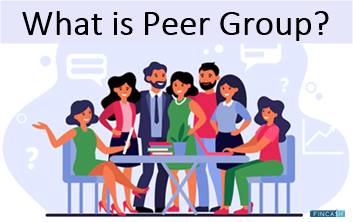Definition of Peer Group
A peer group is a group of people who share one or more common interests or traits. People of various ages can form these, and a person can be a member of many peer groups simultaneously.

Peer influence has a significant impact on a person's life as they grow up. Instead of spending time with their parents, most youngsters spend most of their time with their peers. These groups can have a constructive or detrimental impact on an individual.
Peer Group Examples
Some of the examples of peer groups are as follows:
- Clubs and groups at school
- Colleagues
- Classmates
- Neighbours of the same age
- Sports team members
Peer Group Definition of Psychology
A group of people who have something in common, such as age, social standing, economic status, occupation, or education, is a peer group. Peer group members often engage on an equal footing and exert influence over one another's attitudes, emotions, and behaviour.
Characteristics of Peer Group
Peer groups are defined by a variety of characteristics that connect people.
The following are some of their features:
- Individuals in this category are constantly eager to learn new things and explore new places. They take chances to discover more
- Peer groups can also be used to teach members about gender roles. Group members learn about sex differences and social and cultural expectations through gender-role socialisation
- It serves as a valuable source of knowledge. Peer groups considerably impact group members' psychological and social adaptations. These groups tend to give a different perspective than individual opinions
- Adolescent peer groups help children and teenagers as they integrate into adult society, reducing reliance on parents and promoting self-sufficiency and social connections
- Peer groups create a powerful social milieu in which group norms are formed and maintained through socialisation processes that enhance similarity within the group
Talk to our investment specialist
Types of Peer Group
Cliques and Crowds are the two most common types of peer groups.
- Cliques are groups of people who share a common interest or affinity. This group can have as few as two people and as many as 12-14. People who work in the same job occupation, for example, form friendships and fall into this group
- As the term implies, a crowd is just a big group of individuals gathered in an unorganised manner. They may or may not be acquainted. It includes marathons, candle marches held for social reasons, etc
Advantages of Peer Group
Peer groups can positively or negatively impact an individual's life. Good peer groups are those that have a favourable influence on the individual. There are several advantages to being a part of a good peer group, some of which include:
- This group is constantly encouraging one another. They aid in discovering an individual's skills and how to go about achieving them
- Good peer groups are always focused on accomplishing their goals
- Respect, honesty, humility, discipline, hard work, and other positive and recognised characteristics are developed by members of this peer group
- It aids in the development of healthy habits such as studying and reading
- The Peer group consists of visionaries and focused people who are always keen to learn They constantly have ambitious goals in mind and work hard to achieve them
Peer Group Influence on Child Development
In the phase of development, a child can grasp both good things and bad things. While negative peer pressure can be harmful to a child's development, interaction with positive peers can have a lot of good impacts in a child's early years.
Here is a detailed explanation of how peer groups influence the child development phase:
The physical development of children is strongly influenced by peer groups. The physical activities that young children participate in when they assemble outside to play create healthy, fit, and strong bodies. Games help to build gross motor skills, agility, and reflexes
Interactions with peers help in the emotional development of children. They tend to experience a variety of feelings, such as acceptance and delight, through interactions with their peers. Self-esteem and coping abilities are important for a child's healthy development as they grow older, and peer companionship can help a lot in regards to this. Even playground squabbles and toy fights are good for kids' development because they teach them how to regulate and express stress and anger in a variety of ways
Kids learn how to work together, collaborate and relate to others by socialising with children of their own age. Peer interactions also encourage the development of communication skills, which are essential for social development. Peer relationships encourage a youngster to assess himself in relation to others, which helps him establish a sense of self. Children's interactions with their peers also teach them about acceptable and inappropriate social behaviours
Children share interests, ideas, and viewpoints when they learn cooperatively through partner or group activities. These activities encourage the development of creative, problem-solving, and conflict-resolution abilities in kids. The influence of cognitive development encourages kids to participate in a variety of extracurricular activities and groups to broaden their experiences and social interaction.
Takeaway
Peer groups are made up of comparable individuals who share one or more qualities. They play an essential role in a variety of disciplines of research. Some peer groups are extremely diverse, encompassing socioeconomic status, educational attainment, race, creed, culture, and religion. Peer groups create a powerful social setting in which group norms are formed and maintained through socialisation processes that enhance similarity within the group.
All efforts have been made to ensure the information provided here is accurate. However, no guarantees are made regarding correctness of data. Please verify with scheme information document before making any investment.












